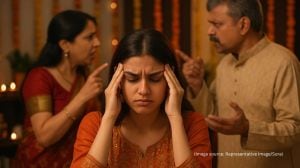An alternative is born
A successful experiment in reducing child mortality rates in one of Maharashtra's poorest districts begs the question: can home-based heal...

A successful experiment in reducing child mortality rates in one of Maharashtra’s poorest districts begs the question: can home-based health workers do the trick where conventional systems have failed? VIVEK DESHPANDE reportsTab C.P.M. for scabies, Furazalitine for dysentry, Paracetamol for fever, Aspirin for bodyache and fever, Septran syrup for pneumonia, Gentamycin for sepsis, Vit K for newborn and Chloroquin for malaria.
When Kajubai Undirwade reels out this medicalese, she’s actually reciting the prescription for an experiment that could give a new lease of life to countless neo-nates and children who face death only because they cannot get treatment in time.
And Kajubai is just one among hundreds of semi-literate women and men who have made the revolution possible in Gadchiroli district of Maharashtra, which is dogged by child deaths. Due to the efforts of a non-governmental organisation, Society for Education, Action and Research in Community Health (SEARCH) run by a doctor couple Abhay and Rani Bang mortality has dropped from 120 per 1,000 deaths between 0-5 years in 1995 to 30 per 1,000 in 1998.
Gadchiroli, a backward district with poor medical facilities, has a male and female paramedic worker per 3,000 people and a primary health centre per 20,000 people. The SEARCH experiment started in 1993 against this backdrop. For two years, the group investigated the number of and reasons for the deaths of children in the age group of 0-5. Neo-natal care was introduced in 39 intervention villages from 1995. SEARCH selected villagers educated minimum up to the primary level and trained them as health workers the women were trained as dais or traditional birth attendants (TBAs). The health workers would prepare a list of prospective mothers in their respective villages and educate them on aspects of child birth in the last three months of pregnancy.
The SEARCH survey revealed that most neo-nates in the area die of pneumonia, sepsis and asphyxia. A parallel study by SEARCH experts was also conducted to check the veracity of the figures arrived at by the health workers. Trained female health workers treated the neo-nates for these ailments, and the prevailing neo-natal death rate of 62 per 1,000 in the intervention area dropped to 25.5 by the third year.
Initially, the team came up against strong opposition from the tribals. “They would simply drive us away,” recalls Dr Sanjay Baitule, who supervises the health workers and provides health education. “Blind faith and crude methods of child delivery were rampant,” he added. For instance, the umblical cord would be cut with the help of a crude preparation of roof tile.
Himka Janbandhu, an attendant from Ambeshivni village, said, “When we started telling them that the traditional methods were harmful, they would become angry. But we stayed put. Now they have realised the importance of maintaining sanity.”
The SEARCH model has now been adopted by the Indian Council of Medical Research (ICMR) foe emulation in the rest of India. In America, the National Academy of Medicine has decided to implement the model in some African countries with the aid of the Save Children Fund. But is there a danger of health workers taking on the role of self-styled doctors? Dr Baitule disagrees. “We have demonstrated that proper selection and training of health workers coupled with strict supervision can make it foolproof,” he says. “Firstly, we pay them incentives. We keep a strict tally of medicines in the special kits provided to them. We also ensure that all the used-up syringes are burnt immediately after use.”
Dr Rani Bang also makes a case for providing legal sanction to home-based neo-natal care by health workers. “It is a cheap and safe way. Legal sanctity can be ensured by adopting the method as policy,” she says.“But the model will have to be employed taking into consideration the local factors,” she adds.
Dr Abhay Bang claims that home-based neo-natal care can reduce neo-natal and infant mortalities by nearly 50 per cent among the malnourished rural populations not only in India but in all the developing countries. The truth in this claim cannot be missed, since reaching healthcare to the poor has remained a dream for this part of the world.
Wedding vows
Abhay Bang was born and brought up in Wardha. His father, Thakurdas Bang is a well-known Gandhian leader there. He met Rani at the Government Medical College in Nagpur. Though trained in clinical medicine, the Bangs had a desire to work in the area of public health. But before that, they enrolled themselves in the John Hopkins University in the US. After returning to India in 1986, the couple set up Shodhgram, the SEARCH headquarters, in a forest 17 kms from Gadchiroli.
At Shodhgram, they conducted a detailed study of the socio-medical problems of the region, involving the villagers in the search for solutions. Their work includes anti-liquor and de-addiction campaigns, sex education for rural youth and health education, besides a regular hospital at Shodhgram.
During the tenure of the Shiv Sena-BJP government regime in Maharashtra, SEARCH established that the government’s figures of child deaths in tribal areas of Gadchiroli smacked of under-reporting. At least 25 per cent of the deaths were not being registered in the government records, it was revealed. Following this, the government directed the District Collector to conduct a survey, which underscored SEARCH’s claim. The government tried to underplay the issue, but pressure by opposition parties forced the then chief minister, Manohar Joshi, to announce measures to tackle the problem.






- 01
- 02
- 03
- 04
- 05

























